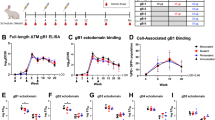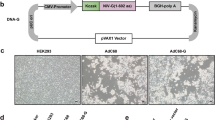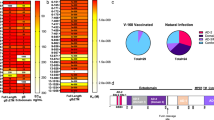Abstract
Naked plasmid DNA (pDNA) vaccine expressing herpes simplex virus type 1 (HSV-1) glycoprotein B (gB) was tested for protective activity against acute HSV-1 infection in mice. The pDNA was intravenously injected into Balb/c mice via their tail vein under high pressure, and the vaccination was performed two times at an interval of 7 days. The gB gene vaccination significantly protected the mice from subsequent intraperitoneal challenge with a lethal dose of HSV-1, which killed all the animals given control plasmid or saline. The protective activity was correlated with the dose of the plasmid inoculated, the survival rate reaching 83% in mice vaccinated with 5 μg of pDNA. The vaccinated mice were also protected from latent HSV infection. The immunized mice showed significant elevation in neutralizing antibody against HSV-1 as well as serum levels of interleukin-12 (IL-12) and interferon-γ (IFN-γ). When mice were immunized with 5 μg of an Epstein–Barr virus (EBV)-based plasmid vector harboring the gB, the cytotoxic T lymphocytes (CTLs) activity and proliferative response for HSV-1 were also induced. The results strongly suggest that intravenous immunization of naked pDNA may induce humoral and cellular immune responses against the virus, leading to a significant prophylactic outcome against HSV-1 infection in mice.
This is a preview of subscription content, access via your institution
Access options
Subscribe to this journal
Receive 12 print issues and online access
$259.00 per year
only $21.58 per issue
Buy this article
- Purchase on Springer Link
- Instant access to full article PDF
Prices may be subject to local taxes which are calculated during checkout






Similar content being viewed by others
References
Tighe H, Corr M, Roman M, Raz E . Gene vaccination: plasmid DNA is more than just a blueprint. Immunol Today 1998; 19: 89–97.
Wolff JA et al. Direct gene transfer into mouse muscle in vivo. Science 1990; 247: 1465–1468.
Liu F, Song YK, Liu D . Hydrodynamics-based transfection in animals by systemic administration of plasmid DNA. Gene Therapy 1999; 6: 1258–1266.
Zhang G, Budker V, Wolff JA . High levels of foreign gene expression in hepatocytes after tail vein injections of naked plasmid DNA. Hum Gene Ther 1999; 10: 1735–1737.
Cui FD et al. Highly efficient gene transfer into murine liver achieved by intravenous administration of naked Epstein–Barr virus (EBV)-based plasmid vectors. Gene Therapy 2001; 8: 1508–1513.
Rouse BT et al. DNA vaccines and immunity to herpes simplex virus. Curr Top Microbiol Immunol 1998; 226: 69–78.
Bernstein DI, Stanberry LR . Herpes simplex virus vaccines. Vaccine 1999; 17: 1681–1689.
Ghiasi H et al. Expression of seven herpes simplex virus type 1 glycoproteins (gB, gC, gD, gE, gG, gH and gI): comparative protection against lethal challenge in mice. J Virol 1994; 68: 2118–2126.
Hanke T, Graham FL, Rosenthal KL, Johnson DC . Identification of an immunodominant cytotoxic T-lymphocyte recognition site in glycoprotein B of herpes simplex virus by using recombinant adenovirus vectors and synthetic peptides. J Virol 1991; 65: 1177–1186.
Burke RL . Contemporary approaches to vaccination against herpes simplex virus. Curr Top Microbiol Immunol 1992; 179: 137–158.
Cose SC, Kelly JM, Carbone FR . Characterization of a diverse primary herpes simplex virus type 1 gB-specific cytotoxic T-cell response showing a preferential Vβ bias. J Virol 1995; 69: 5849–5852.
Fu TM et al. Induction and persistence of a cytotoxic T lymphocyte (CTL) response against a herpes simplex virus-specific CTL epitope expressed in a cellular protein. Virology 1996; 222: 269–274.
Mikloska Z, Cunningham AL . Herpes simplex virus type 1 glycoproteins gB, gC and gD are major targets for CD4 T-lymphocyte cytotoxicity in HLA-DR expressing human epidermal keratinocytes. J Gen Virol 1998; 79: 353–361.
Chen ZY et al. Linear DNAs concatemerize in vivo and result in sustained transgene expression in mouse liver. Mol Ther 2001; 3: 403–410.
Stoll SM et al. Epstein–Barr virus/human vector provides high-level, long-term expression of alpha1-antitrypsin in mice. Mol Ther 2001; 4: 122–129.
Lui VWY, He Y, Falo L, Huang L . Systemic administration of naked DNA encoding interleukin 12 for the treatment of human papillomavirus DNA-positive tumor. Hum Gene Ther 2002; 13: 177–185.
Itokawa Y et al. Hydrodynamics-based immuno-gene therapy against metastatic liver tumor and peritoneal carcinomatosis. Mol Ther 2002; 5: S101 (Abstract 304).
Kishida T et al. Complete rejection of metastatic lymphoma in murine liver by in vivo transduction with IL-21 and IL-15 genes. Mol Ther 2002; 5: S120–121, (Abstract 366).
Ulmer JB et al. Heterologous protection against influenza by injection of DNA encoding a viral protein. Science 1993; 259: 1745–1749.
Raz E et al. Intradermal gene immunization: the possible role of DNA uptake in the induction of cellular immunity to viruses. Proc Natl Acad Sci USA 1994; 91: 9519–9523.
Zarozinski CC et al. Protective CTL-dependent immunity and enhanced immunopathology in mice immunized by particle bombardment with DNA encoding an internal virion protein. J Immunol 1995; 154: 4010–4017.
Yokoyama M, Zhang J, Whitton JL . DNA immunization confers protection against lethal lymphocytic choriomeningitis virus infection. J Virol 1995; 69: 2684–2688.
Fuller DH, Haynes JR . A qualitative progression in HIV type 1 glycoprotein 120-specific cytotoxic cellular and humoral immune responses in mice receiving a DNA-based glycoprotein 120 vaccine. AIDS Res Hum Retroviruses 1994; 10: 1433–1441.
Davis HL, Schirmbeck R, Reimann J, Whalen RG . DNA-mediated immunization in mice induces a potent MHC class I-restricted cytotoxic T lymphocyte response to the hepatitis B envelope protein. Hum Gene Ther 1995; 6: 1447–1456.
Geissler M, Gesien A, Tokushige K, Wands JR . Enhancement of cellular and humoral immune responses to hepatitis C virus core protein using DNA-based vaccines augmented with cytokine-expressing plasmids. J Immunol 1997; 158: 1231–1237.
Lin H et al. Expression of recombinant genes in myocardium in vivo after direct injection of DNA. Circulation 1990; 82: 2217–2221.
Manickan E et al. Genetic immunization against herpes simplex virus. Protection is mediated by CD4+ T lymphocytes. J Immunol 1995; 155: 259–265.
Kriesel JD, Spruance SL, Daynes RA, Araneo BA . Nucleic acid vaccine encoding gD2 protects mice from herpes simplex virus type 2 disease. J Infect Dis 1996; 173: 536–541.
Kuklin N et al. Induction of mucosal immunity against herpes simplex virus by plasmid DNA immunization. J Virol 1997; 71: 3138–3145.
Mester JC, Twomey TA, Tepe ET, Bernstein DI . Immunity induced by DNA immunization with herpes simplex virus type 2 glycoproteins B and C. Vaccine 2000; 18: 875–883.
Caselli E et al. Mice genetic immunization with plasmid DNA encoding a secreted form of HSV-1 gB induces a protective immune response against herpes simplex virus type 1 infection. Intervirology 2001; 44: 1–7.
Bourne N, Stanberry LR, Bernstein DI, Lew D . DNA immunization against experimental genital herpes simplex virus infection. J Infect Dis 1996; 173: 800–807.
Ghiasi H et al. Vaccination of mice with herpes simplex virus type 1 glycoprotein D DNA produces low levels of protection against lethal HSV-1 challenge. Antiviral Res 1995; 28: 147–157.
McClements WL, Armstrong ME, Keys RD, Liu MA . Immunization with DNA vaccines encoding glycoprotein D or glycoprotein B, alone or in combination, induces protective immunity in animal models of herpes simplex virus-2 disease. Proc Natl Acad Sci USA 1996; 93: 11414–11420.
Sin JI et al. In vivo modulation of vaccine-induced immune responses toward a Th1 phenotype increases potency and vaccine effectiveness in a herpes simplex virus type 2 mouse model. J Virol 1999; 73: 501–509.
Rous RJD et al. Induction in vitro of primary cytotoxic T-lymphocyte responses with DNA encoding herpes simplex virus proteins. J Virol 1994; 68: 5685–5689.
Manickan E et al. Enhancement of immune response to naked DNA vaccine by immunization with transfected dendritic cells. J Leukoc Biol 1997; 61: 125–132.
Perelygina L, Patrusheva I, Zurkuhlen H, Hilliard JK . Characterization of B virus glycoprotein antibodies induced by DNA immunization. Arch Virol 2002; 147: 2057–2073.
Sin JI et al. IL-12 gene as a DNA vaccine adjuvant in herpes mouse model: IL-12 enhances Th1-type CD4+ T cell-mediated protective immunity against herpes simplex virus-2 challenge. J Immunol 1999; 162: 2912–2921.
Johnson RM, Lancki DW, Fitch FW, Spear PG . Herpes simplex virus glycoprotein D is recognized as antigen by CD4+ and CD8+ T lymphocytes from infected mice. Characterization of T cell clones. J Immuol 1990; 145: 702–710.
Koelle DM et al. Antigenic specificities of human CD4+ T-cell clones recovered from recurrent genital herpes simplex virus type 2 lesions. J Virol 1994; 68: 2803–2810.
Nugent CT, Wolcott RM, Chervenak R, Jennings SR . Analysis of cytolytic T-lymphocyte response to herpes simplex virus type 1 glycoprotein B during primary and secondary infection. J Virol 1994; 68: 7644–7648.
Ghiasi H et al. The importance of MHC-I and II responses in vaccine efficacy against lethal herpes simplex virus type 1 challenge. Immunology 1997; 91: 430–435.
Kita M, Tong LJ, Imanishi J . Induction de I’ARN messager des cytokines par I’infection de I’herpes simplex virus chez la souris. C R Soc Biol 1993; 187: 561–568.
Rogers JV et al. Murine response to DNA encoding herpes simplex virus type-1 glycoprotein D targeted to the liver. Vaccine 2000; 18: 1522–1530.
Ambinder RF et al. Functional domains of Epstein–Barr virus nuclear antigen EBNA-1. J Virol 1991; 65: 1466–1478.
Fischer N et al. Epstein–Barr virus nuclear antigen 1 forms a complex with the nuclear transporter karyopherin α2. J Biol Chem 1997; 272: 3999–4005.
Jankelevich S, Kolman JL, Bodnar JW, Miller G . A nuclear matrix attachment region organizes the Epstein–Barr viral plasmid in Raji cells into a single DNA domain. EMBO J 1992; 11: 1165–1176.
Wysokenski DA, Yates JL . Multiple EBNA1-binding sites are required to form an EBNA1-dependent enhancer and to activate a minimal replicative origin within oriP of Epstein–Barr virus. J Virol 1989; 63: 2657–2666.
Gahn TA, Sugden B . An EBNA-1-dependent enhancer acts from a distance of 10 kilobase pairs to increase expression of Epstein–Barr virus LMP gene. J Virol 1995; 69: 2633–2636.
Mazda O, Satoh E, Yasutomi K, Imanishi J . Extremely efficient gene transfection into lympho-hematopoietic cell lines by Epstein–Barr virus-based vectors. J Immunol Methods 1997; 204: 143–151.
Maruyama-Tabata H et al. Effective suicide gene therapy in vivo by EBV-based plasmid vector coupled with polyamidoamine dendrimer. Gene Therapy 2000; 7: 53–60.
Harada Y et al. Highly efficient suicide gene expression in hepatocelluar carcinoma cells by Epstein–Barr virus-based plasmid vectors combined with polyamidoamine dendrimer. Cancer Gene Ther 2000; 7: 27–36.
Tanaka S et al. Targeted killing of carcinoembryonic antigen (CEA)-producing cholangiocarcinoma cells by polyamidoamine dendrimer-mediated transfer of an Epstein–Barr virus (EBV)-based plasmid vector carrying the CEA-promoter. Cancer Gene Ther 2000; 7: 1241–1250.
Kishida T et al. In vivo electroporation-mediated transfer of interleukin-12 and interleukin-18 genes induces significant antitumor effects against melanoma in mice. Gene Therapy 2001; 8: 1234–1240.
Asada H et al. Significant antitumor effects obtained by autologous tumor cell vaccine engineered to secrete interleukin (IL)-12 and IL-18 by means of the EBV/lipoplex. Mol Ther 2002; 5: 609–616.
Nakanishi H et al. Nonviral genetic transfer of Fas ligand induced significant growth suppression and apoptotic tumor cell death in prostate cancer in vivo. Gene Therapy 2003; 10: 434–442.
Mazda O . Application of Epstein–Barr virus (EBV) and its genetic elements to gene therapy. In: Cid-Arregui A, Garcia-Carranca A (eds). Viral Vectors: Basic Science and Gene Therapy. Eaton Publishing: Natick, 2000, pp 325–337.
Mazda O . Improvement of nonviral gene therapy by Epstein–Barr virus (EBA)-based plasmid vectors. Curr Gene Ther 2002; 2: 379–392.
Tomiyasu K et al. Direct intra-cardiomuscular transfer of β2-adrenergic receptor gene augments cardiac output in cardiomyopathic hamsters. Gene Therapy 2000; 7: 2087–2093.
Satoh E et al. Successful transfer of ADA gene in vitro into human peripheral blood CD34+ cells by transfecting EBV-based episomal vectors. FEBS Lett 1998; 441: 39–42.
Mazda O et al. Non-viral strategies for immuno-gene therapy. In: Cancro MP (ed). Recent Research Developments in Immunology Vol. 2. Research Signpost: Trivandrum, 2000, pp 273–281.
Niwa H, Yamamura K, Miyazaki J . Efficient selection for high-expression transfectants with a novel eukaryotic vector. Gene 1991; 108: 193–199.
Yates JL, Warren N, Sugden B . Stable replication of plasmids derived from Epstein–Barr virus in various mammalian cells. Nature 1985; 313: 812–815.
Con RW et al. Extended duration of herpes simplex virus DNA in genital lesions detected by the polymerase chain reaction. J Infect Dis 1991; 164: 757–760.
Acknowledgements
The present study was supported by a grant in aid from the Japanese Ministry of Education, Culture, Sports, Science and Technology.
Author information
Authors and Affiliations
Rights and permissions
About this article
Cite this article
Cui, FD., Asada, H., Kishida, T. et al. Intravascular naked DNA vaccine encoding glycoprotein B induces protective humoral and cellular immunity against herpes simplex virus type 1 infection in mice. Gene Ther 10, 2059–2066 (2003). https://doi.org/10.1038/sj.gt.3302114
Received:
Accepted:
Published:
Issue Date:
DOI: https://doi.org/10.1038/sj.gt.3302114
Keywords
This article is cited by
-
High pressure treatment under subfreezing temperature results in drastic inactivation of enveloped and non-enveloped viruses
Biotechnology Letters (2013)
-
Hydrodynamic Gene Delivery: Its Principles and Applications
Molecular Therapy (2007)
-
Gene therapy progress and prospects: Hydrodynamic gene delivery
Gene Therapy (2007)
-
Cytokine genetic adjuvant facilitates prophylactic intravascular DNA vaccine against acute and latent herpes simplex virus infection in mice
Gene Therapy (2005)
-
Gene Therapy Progress and Prospects: Episomally maintained self-replicating systems
Gene Therapy (2004)



